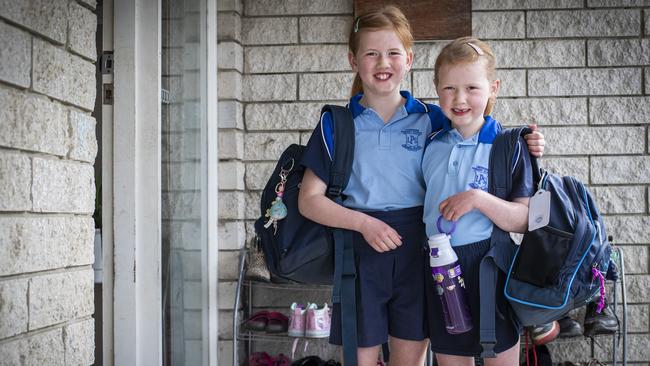STUDENTS at some Tasmanian primary schools are spending the equivalent of five weeks less in class each year than their counterparts because of variations in school hours.
A Mercury analysis of school times has revealed significant differences between schools in the public system.
SCROLL DOWN TO SEE HOW YOUR SCHOOL COMPARES
Taking into account differences in start times, recess and lunch periods, and the final bell, students are spending between four and a half and five and a quarter hours learning per day.
Over the course of a year, students at the schools with the longer class times spend the equivalent of five weeks extra learning.

Labor’s Education spokesman Josh Willie said he was concerned about the cumulative effect.
“From my perspective, there’s a clear equity issue,” he said.
“It doesn’t appear to be a big deal over the course of a day but across a year or years of schooling, some children are missing out significantly compared to their peers.
“It’s a universal system and every child should be given the same access and same opportunities.
“The discrepancy in break times I think is an issue too — we know that play is really important for childhood development and there may be differences in break times across schools.”
“I’m aware that Minister (Jeremy) Rockliff and the department know about these issues and they should be working with school communities to address it and to put more equity into the system.”
Mr Willie called on the government to conduct research on the effect of differing school contact hours and to make it public.
“I think there is room for some flexibility across schools, but there seems to be wide discrepancies between schools and if you do the maths, there are kids who are missing out on days of schooling across the year.
“The state government is providing education to Tasmanian kids, there should be some consistency and the rationale that kids get the same access and same opportunity.”
Education Minister Jeremy Rockliff said the issue was being examined.
“Some of the reasons are historical, some of the reasons are to do with transport arrival and departure times,” he said.
“What is important though is the consistency of contact hours and work is underway and will continue to ensure the consistency of contact hours, which I believe is relatively consistent already within the school day, it’s my understanding that we make sure we maximise the opportunities, maximise the need to have those consistent contact hours.”

The Mercury understands that consultation is under way between the Department of Education, schools and the Australian Education Union about school hours to balance between contact hours, workloads and local considerations.
The Department is understood to be reviewing contact hours, instructional loads and timetabling.
Tasmanian public schools set their own hours, with the goal of providing a consistent number of contact hours.
The Mercury compiled a list of times from the websites of 30 Tasmanian public primary schools.
Start times varied from 8.45am to 9am and finish times from 2.25pm to 3pm.
And the total amount of time students spend at recess and lunch varied from 45 minutes to 75 minutes.
At Burnie Primary, recess is 15 minutes; at Howrah Primary, it is half an hour.
At Penguin District Primary, a student can expect to spend four hours and 30 minutes in class a day, while at Illawarra Primary at Blackmans Bay, it is five hours and 12 minutes.
Some schools also begin the day with a short physical education session of up to 15 minutes and others provide supervised eating time before lunchtime formally begins.
Dr Sally Milbourne from the Tasmanian Principals Association said it was important for schools to be able to set their operating hours based on a combination of research, experience and local knowledge of their communities.
“There are variations in school hours, part of it is a historical reason, it goes back to when there was less availability of transport for some country schools,” she said.
“School hours are quite complex, you have the envelope of the starting and finishing time and then you have at least two breaks for recess and lunchtime and they can vary.
“Do they have a longer block because they have literacy block which many schools do?
“In lots of schools, recess might look shorter but they may well get a fruit breaks in the middle of the morning session if it’s a long session, they’ll have a stand-up stretch, some water and a fruit break.
She said it was good to have a discussion about the issue with an open mind about the potential impacts and outcome.

“Schools will make best decisions based on their own local context,” she said.
“What might serve the needs of a school where kids are an hour’s bus trip away might be different to a school with the inner city school in one of our metropolitan areas where the kids are walking to school or they’ve got a five minute commute in a car.”
“It’s a fine balance. There are some things that need to be uniform across the state and some things that are contextual.
Tasmanian Association of State School Organisations president Jarad Dickason said the issue wasn’t one which was high on the list of those raised by parents and families.
The contact that schools and families have had with each other during COVID-19 has been unprecedented and TASSO hopes that the two way communication continues,” he said.
“We have not had contact with the Department or families in relation to contact hours.”
“The quality of educational programs aligned to the curriculum and two-way communication between families and schools, were more important factors in determining engagement with education resulting in positive outcomes.”
‘The 9 to 3 grind’
SCHOOL days are a fact of life for Avalon and Florence Teirney of Lindisfarne.
The local primary school starts its day at 9am and the final bell rings at 2.55pm.

In between is recess, lunch and a fruit break to divide up the day. It’s a middle-of-the road routine for a Tasmania primary school.
Dad James Teirney says that while the fruit break is a recent innovation, nothing much has changed since he was at school.
“It’s just one of those things, it’s just how it is, isn’t it. It was definitely around the nine to three mark,” he said.
“Regular school hours make sense, but is has never come up whether the school should start earlier of later.”
He was surprised to learn there was much of a difference between schools.
“It’s state run, so it’s surprising that things are different because it’s all run by the Department of Education, so why aren’t they all the same?
“I don’t have any issues with it, it seems to work well and I don’t imagine the hours would ever change greatly.”
Mr Teirney said that while he agreed it was desirable that students have a similar amount of time in classrooms, schools were well placed to make decisions about their local circumstances.
“You want children progressing at the same or a similar rate if schools in different communities need longer or less — as long as it all works out.”


Add your comment to this story
To join the conversation, please log in. Don't have an account? Register
Join the conversation, you are commenting as Logout
Parents fear ‘collateral damage’ kids
Nova 96.9 co-hosts and devoted dads Fitzy and Wippa are backing the PM’s Spelling Bee as exclusive research reveals majority of parents worry kids’ literacy is suffering.
WATCH: Five ways Aussies can protect their kids now
In the wake of child sex allegations against a Melbourne childcare worker, an expert has revealed tips to help parents and carers to safeguard their children. Watch the video.